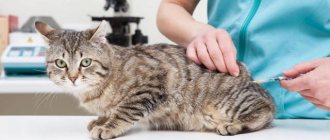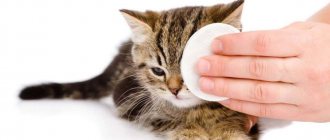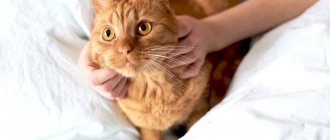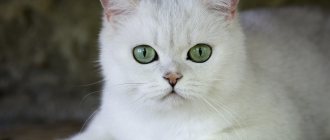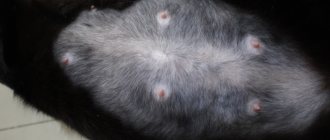Causes of hair loss
Among the conditions that cause hair loss at the base of the tail and along its entire length are various pathologies, both skin and systemic. Possible reasons for the appearance of such a specific symptom:
- Endocrine disorders;
- Avitaminosis;
- Dermatitis and dermatomycosis;
- Disruption of the gastrointestinal tract;
- Parasites;
- Lichen.
In most cases, if a cat's tail comes off, the reason lies in parasites. In this case, the animal independently tears out the fur, combing and biting the base of the tail in an attempt to get rid of fleas. Alopecia is often accompanied by the appearance of wounds and erosions, which are caused by constant scratching of this area. Diagnosing parasites is simple - just carefully examine the animal’s skin. Even if fleas are not noticeable, nits may appear. They resemble small black dots that are difficult to see with the naked eye. In animals with sensitive skin, nits can cause irritation, which is accompanied by itching and forces the cat to scratch the affected area.
Another common cause is ringworm. A fungal disease is manifested by the formation of a bald spot of a regular shape on the cat’s skin. In the affected area, the fur thins and scabs or peeling appear. The disease progresses quickly and, if the lichen is localized at the base of the tail, over time it spreads to the entire length of this part of the body and the back of the animal. It is important to remember that lichen is highly contagious for both animals and humans. It must be treated with special ointments and solutions for treating the skin.
Diagnosis and treatment
After discovering lost hair, it is necessary to urgently show your pet to a veterinarian, since at home there is no way to understand the cause of the disease. To make a diagnosis, the veterinarian will carry out the following procedures: collect anamnesis (interview the owner about past diseases, nutrition); conduct an external examination for the presence of characteristic symptoms; will take blood and skin scrapings for study. If necessary, ultrasound diagnostics are performed. After determining the cause of alopecia, the doctor prescribes treatment recommendations:
- Fleas. Elimination of parasites is carried out using shampoos (Fitoelita, Lugovoy, Celandine), drops on the withers (Stronghold, Advocate, Bars), sprays (Delix, Frontline). For prevention, it is recommended to wear a flea collar.
- Lichen. Treatment is usually local - shampoos (Doctor, Alezan, Antifungal), ointments (Yam, Sanderm), Fungin is effective. Vaccines are common for treatment and prevention - Polivac, Vakderm.
- Avitaminosis. If the animal is fed natural products, it is recommended to add a vitamin complex. It is better to give pregnant cats special food designed for this condition. Sometimes doctors prescribe sulfur preparations and immunostimulants.
- Hormonal imbalances, dermatitis, stress - specific treatment depending on the identified problem.
- Inflammation of the paraanal glands. Treatment – massaging the anus area from the outside or inside, treatment with an antiseptic through a catheter. If necessary, antibiotics and rectal suppositories are prescribed to relieve inflammation.
- Allergy. The irritant is eliminated and antihistamines are given.
If your cat's tail comes off, then the best method of preventing this symptom is prevention. It is enough to provide adequate feeding and care, regular examinations and monitoring of the pet’s condition.
Vitamin deficiency as a cause of alopecia
Quite often, a pregnant cat becomes bald near the tail. In this case, we are talking about a lack of nutrients - vitamins and microelements. A cat bearing kittens needs a special diet, taking into account the changing needs of the body. Alopecia in pregnant animals should be treated by changing their diet. If the cat's diet consists of natural food, it should be supplemented with special fortified supplements. Dry food during pregnancy must be replaced with special products intended for pregnant cats. Such foods are distinguished by a large amount of vitamins and microelements that cover the body’s need for these substances.
You might be interested in: Why does a cat vomit foam?
Vitamin deficiency also affects small kittens and older animals. This problem occurs especially often in kittens taken from the street. Due to the lack of normal nutrition, the immunity of animals weakens, against which a number of diseases develop, including hair loss. In all cases, you can get rid of the symptom only by adjusting your diet.
You should consult your veterinarian about the need to administer special supplements to older animals (over 7 years old). The fact is that at this age, alopecia may be a consequence of systemic disorders that need to be identified and, if possible, corrected.
Signs of the disease
If the reason lies in the invasion of a pathogenic fungus, the cat not only loses hair, but also crusts and scabs appear in large numbers, and the skin on the affected areas can become very flaky (pictured). Scabies is characterized by severe itching, redness, and even the appearance of foci of purulent inflammation.
With dermatitis, the main manifestation is severe and painful redness of the skin, local body temperature can rise significantly, the cat is constantly itching, sometimes it comes to wounds and ruptures of the skin. Various diseases of the endocrine system (feline endocrine alopecia) are also common, the clinical manifestations of which can be very diverse.
The owner of the animal should be alert to signs of unusual, severe hair loss, especially if this process is noticeable in certain areas (on the back, neck, around the tail or on the paws). You should carefully examine the skin in the affected area. The skin may be pink and clear, but in some cases scales, sores, scabs, or bumps may appear on the skin. In particularly advanced cases, skin inflammation with slight suppuration may occur.
With a disease associated with a disorder in the endocrine system, the skin at the site of the lesion loses its elasticity. An animal can react differently to touching the affected area, from complete indifference to outright aggression.
This type of alopecia is quite common. Often the animal will scratch or chew out the itchy areas on its own. This phenomenon is often observed in cats during lactation or pregnancy. In this case, it is recommended to include additional vitamin complexes in the diet, and it is also recommended to reduce the lactation time for babies if possible.
In some cases, the cause of cat tail baldness is oily seborrhea, which manifests itself in excess sebum secretion. In this case, special shampoos containing salicylic acid help perfectly.
We suggest you read: Vitamins for eyelash growth at home
Alopecia is a common type and it is very difficult to understand the cause of the disease. For this reason, the best way out of the situation is to visit a veterinarian.
Quite often, cats can injure themselves by vigorously licking areas of fur on their bellies. Sometimes this can be a reaction to flea bites. For this reason, even if fleas are not visible on the animal, you should try to treat the animal against these parasites.
In some cases, baldness occurs at the site of surgical injuries and injection sites; in this case, traumatic alopecia occurs and time and the help of a specialist will help to overcome it.
Baldness on the back
The causes of this type of alopecia can be different, but quite often it is associated with a lack of vitamin B. In this case, a balanced diet and the use of vitamin complexes can help, the veterinarian should help in the selection.
This type of baldness is called periaucular alopecia. It occurs very often and most often in cats with short hair, and cat owners do not observe signs of other pathologies.
The reasons may be different, but experts say that in this case, an allergic reaction most often occurs. The most common allergens are proteins (both animal and plant), very often cats do not perceive lamb, and this may also be a specific reaction to cereals.
Quite often, the cause of this phenomenon is a lack of vitamins and especially vitamin D. However, the hormonal factor should not be discarded; quite often such alopecia is caused by hormonal changes. In both the first and second cases, there are different treatment regimens, which the veterinarian will select individually in each case.
A rather unpleasant type of alopecia. This is usually a sign of infection and requires immediate attention from a veterinarian.
Even a cat who has never been outside can develop a phenomenon called alopecia in the neck area. Most often this is a sign of lichen. The disease is serious and requires complex treatment, which can only be prescribed by a professional.
Dermatitis is always accompanied by itching, so the cause of tail baldness is not illness, but discomfort, due to which the cat is forced to scratch the skin, which leads to hair loss. Dermatitis is treated with ointments and shampoos. The cause of the disease may be waste products of parasites, bacterial infections or an allergic reaction.
Another cause of hair loss is fungal diseases. The disease is characterized by flaking of the cat's skin, sometimes itching. A specific symptom is uniform patchy baldness in the affected area. For treatment, antifungal drugs are used in the form of ointments, solutions and shampoos. The animal is prescribed gentle nutrition for the entire duration of treatment.
Hair loss on the back and tail can be caused by dysfunction of the sebaceous glands located in this area. Only a veterinarian can accurately diagnose the cause of alopecia in a pet. Treatment can be carried out at home, but with the condition of timely detection of the disease that triggered the cat’s hair loss.
We suggest you read: Treatment of focal baldness
Cat's tail coming off photo
First aid
A pet's hanging tail is the first sign that any disease is beginning. It may be associated with a nervous disorder or be a harbinger of physical illness. Neglected treatment or its absence will lead to complications and deterioration of the cat’s health.
If your cat has a drooping tail, then first you need to feel it from the base of the tail to the tip. A cat’s painful reaction to touch signals the onset of the disease. A veterinarian will provide effective assistance, and you should try to determine whether the tip of the tail is broken or whether there are any wounds. In case of a fracture, a tight bandage is applied, and if scratches are noticeable, then the wound needs to be treated. Also, one of the reasons for this ailment is nerve rupture. The presence of a gap is determined by inspection of the tail.
If it does not move entirely, but, for example, only at the base and tip, and the middle reaches towards the floor and is in a hanging state, then this diagnosis will be confirmed. Also, do not forget about the emotional trauma of your pet. In the event of the loss of a beloved owner or the loss of offspring, he will be in a state of stress
At such moments it is especially important to show your love and care, otherwise the cat’s tail will droop and body disorders may begin.
Endocrine disorders
Causes of alopecia in animals include hormonal changes, metabolic disorders and obesity. If, after castration, the cat’s tail has peeled off at the base, this is a manifestation of hormonal alopecia. The same is true for cats that have recently undergone sterilization. The animal’s hormonal levels can normalize on their own, but in some cases drug therapy is necessary.
When metabolic disorders occur in overweight animals, hormonal imbalance is also observed. Such cats need dietary nutrition, the introduction of vitamin and mineral supplements into the diet and medication.
What to do if your cat's ears are going bald?
In some aspects, a cat's body is similar to a human's. For example, in cats, just like in people, problems with internal organs are reflected in their appearance. Typically, cat shedding is not something out of the ordinary, but if the hair does not recover, then you can start to worry. If a cat's ears become bald, the owner can definitely begin to take decisive measures to save his pet.
First, you need to figure out why your cat's ears are going bald. In fact, this symptom can be triggered by anything, from allergies to stress, and only a veterinarian can determine the real cause.
shutterstock
However, there are several common factors:
- Allergic reactions;
- Skin infections and parasites;
- Psychogenic influence;
- Hormonal disorders;
- Heredity.
Allergy
Allergic reactions can occur due to toxic substances and various environmental factors; A new food or medication can also provoke an allergy, as a result of which the hair on the cat’s ears falls out, the shells themselves turn red, become covered with a rash, and begin to itch unbearably, which is why the animal scratches its ears too much. Treatment is carried out in only one way - isolating the allergen from the cat's diet or environment and using medications prescribed by the veterinarian.
Skin infections and parasites
- Otodectosis or scabies. Otodectosis occurs due to infection with ear mites, which can cause purulent otitis media. The ears become red and itchy, and the itching can spread down to the neck, causing the cat to try to relieve it by scratching itself excessively. This is what causes baldness.
- Ringworm and other fungal infections. Fungi are very dangerous, so they try to exclude lichen as the cause of baldness in the first place. Emergency veterinary assistance is especially necessary if ear hair loss is accompanied by redness and rash.
- Viruses. Viral infections that cause hair loss in a cat's ears can affect any organ, from respiratory diseases to eye lesions. Only a specialist will help determine what exactly the animal is sick with and choose the right medications; self-medication can only worsen the cat’s condition.
shutterstock
Stress
Emotional turmoil does not always have a very good effect on animals. A change in the environment surrounding people can lead to the fact that their nervous system cannot stand it: the cat may refuse to eat, begin to hide, the owners may notice that its hair is falling out (on the ears and not only). If symptoms have recently appeared, you can try to calm your pet yourself. For long-term effects of stress, it is better to consult a specialist.
Hormonal disorders in the cat's body
Very often, ears go bald when hormonal problems are diagnosed. One of the manifestations of such disorders is hyperthyroidism - in 30% of cases, in addition to other symptoms, the ears become bald. A cat may also have hypothyroidism. Both of these diseases are associated with dysfunction of the thyroid gland. With diabetes, the hair throughout the body begins to dull and fall out.
Unfortunately, only a veterinarian can accurately determine the disease, so if symptoms appear, it is better to seek help.
Heredity.
Sometimes receding hairlines on and behind the ears appear as a result of a gene mutation and are passed on from generation to generation. Perhaps the ancestors of the balding cat had individuals with similar bald spots? In this case, you don’t have to worry about the health of your pet’s ears.
shutterstock
Why is this happening?
Among the causes of baldness are:
- Lichen. Typical signs of lichen: peeling of the tail, parts of the hind legs, back and ears. An accurate diagnosis can only be made in laboratory conditions. The affected areas are illuminated with a Wood's lamp. If the fur takes on a greenish tint, treatment for shingles infection is prescribed.
- Hormonal imbalances. The cat's body secretes a special substance from the upper part of the tail. The pet distributes lubricant throughout the body while washing. Too active secretion leads to the fact that the tail peels off and becomes fat.
- Ticks and fleas. Even a domestic cat can become infected with fleas. Ticks are brought in from the street by other residents of the house. The area of the mane and tail is a favorite place for parasites, after which the cat begins to constantly itch and literally tear out the fur.
- Infection with helminths. These are parasites that form in the body. Helminths are transmitted through raw fish and meat. This leads to the cat having a loose tail, and worms become a related problem.
- Bacteria. Typical for cats that periodically go outside. Untreated wounds on the tail are a target for bacteria, which can lead to critical infection and a threat to life.
- Allergy. If your cat's tail is going bald, it could be a response to an allergy. Among the reasons: poor nutrition, cheap food, intoxication with medications. In addition, some cats react painfully to odors, particularly tobacco smoke.
- Stress. As in the case of the appearance of worms, the tail peels off during strong emotional experiences. In older cats, this is a consequence of the appearance of a new pet - a dog or kitten. In young furry animals, stress manifests itself after major home renovations, childbirth, or moving to a new place.
- Inflammation of the glands of the paraanal type. The animal begins to urinate past the tray, and the fact of irritation is confirmed by a shaking tail, which gradually becomes greasy, peels off and loses its fur.
shutterstock
When should you sound the alarm?
Reasons why a cat lowers its tail:
- A strong blow or fracture can cause the cat to not raise its tail.
- Damage to nerve endings is also a possible problem. It is impossible to start treatment, since this organ is an extension of the spine and its integrity is necessary for full-fledged work.
- Stroke - if the animal is of advanced age, this will cause the cat’s tail to hang. In this case, the veterinarian will prescribe antibiotics that will return the tail to its normal position in whole or in part. But relapse can happen again.
- Nerve problems - living in stressful conditions. For example, if a cat is oppressed, often beaten, or he is simply not yet accustomed to new owners who have just adopted a new four-legged friend, then he will behave nervously. At such moments, you should not rush to establish a connection with the cat, because good relationships are formed over time, when the animal gets used to the new environment.
- Safety of your offspring. It’s not uncommon for cats to want to protect kittens from exposure to humans or other dangers. This often happens if a pregnant cat does not have her own secluded place where she can safely give birth and raise her offspring. Until the time comes, she will walk from corner to corner with her tail lowered, and look for a suitable option.
- Hereditary predisposition. Often, after crossing different breeds, kittens with deformities are born. Most often, such a developmental deviation does not cause discomfort.
- If the animal is tired, then this position will be a characteristic feature. In this case, the cat needs to be allowed to sleep and rest.
Almost all symptoms will be accompanied by a lack of appetite and unusual behavior.
Prevention measures
The main guarantee of a pet’s health is a strong immune system. In order for the animal to get sick less, it is necessary to create comfortable living conditions for it.
It is important to take care of a complete diet, which will include all the necessary vitamins and minerals. You should not feed your pet cheap food, because they contain low-quality ingredients and can cause allergies.
Among ready-made food, preference should be given to premium and super-premium class.
Care should be taken to ensure that the cat’s diet does not contain prohibited foods: fatty meat, legumes and potatoes, sweets, smoked meats, pickles, chocolate, milk. Fish should be given no more than once a week. Cats are often allergic to chicken, so it is better to replace it with lean veal or turkey.
Also, do not forget about hygiene. The animal should be kept in a clean room, which must be constantly cleaned and ventilated
It is important that the cat does not have access to plants that are poisonous to it. Many of them can also lead to an allergic reaction or irritation and scratching of the skin.
Long-haired cats need to be combed regularly to prevent tangles from forming. The coat and skin should be periodically examined for parasites or inflammation. But it is not advisable to bathe cats often. This may lead to skin problems in the future.
The cat must have all required vaccinations according to age. The animal must be treated for fleas and ticks. Do not forget about the prevention of helminth infection, which must be done every 4-6 months. Moreover, you should not refuse it for completely domestic cats.
At least once a year, your cat should be taken to a veterinarian for a preventive examination. This is especially true for older animals, who are more prone to various diseases.
Thus, scratching in cats is most often just a symptom that indicates some other disease. Severe itching can be a sign of serious animal health problems. Some skin infections in cats are also dangerous to humans. This is why you should not ignore this symptom.
If your cat is constantly scratching in one area, she should be seen by a veterinarian. Only a correct diagnosis will help you quickly and effectively get rid of the problem.



